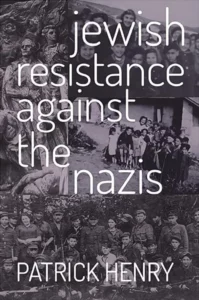 Book Chapter: Jewish Resistance Against the Nazis (Patrick Henry, Editor)
Book Chapter: Jewish Resistance Against the Nazis (Patrick Henry, Editor)
Patrick Henry’s superb collection of essays provides a comprehensive treatment of Jewish resistance during the Holocaust. The contributors are among the most respected Holocaust scholars in Israel, Europe, Canada, and the United States and their writing and scholarship are uniformly cogent and excellent, a tribute to the editorial skills of Patrick Henry. The volume puts to rest the myth that Jews went passively to their deaths—an historical assumption that issue has been contended before, but never in such a comprehensive and sweeping manner. All major approaches and geographical sites are addressed. The first section contains three essays that debunk the charge of Jewish passivity. Particularly useful are Berel Lang and Nechama Tec’s pieces. The eight essays of the second section deal with Jewish resistance in France, Belgium, Italy, Greece, Holland, Scandinavia, and the Yishuv. The third section contains three essays that focus on children as resistors and music as resistance. The essays by Debórah Dwork and Nick Strimple are particularly noteworthy. The nine essays in the final section address Jewish resistance in Central and Eastern Europe, with Yehuda Bauer, Dalia Ofer, Dieter Kuntz and Robert Jan van Pelt headlining a group of especially strong contributions.” Read the full review. – Michael N. Dobkowski, New Jewish Book Council Reviews, Jewish Book Council, August 14, 2015.
“The avowed mission of this collection of interpretive essays and regional case studies is to dispel, once and for all, the myth of Jewish passivity during the Holocaust. The international contributors work from a consensus view that the term “resistance,” in the sense of taking up arms against the oppressor, is too narrow to be useful and, in fact, distorts the realities. The authors operate on a much broader view of what constituted resistance in impossibly difficult conditions: not only partisan warfare and heroic uprisings in ghettos and camps, but everything from flight, hiding, and rescue (accounting for 5-10 percent of survivors) to the maintenance of a cultural existence in captivity, continuing religious observance, staying personally clean, and even struggling against individual and collective feelings of lethargy and resignation. While this expansive typology may stretch the idea of ‘fighting back’ beyond traditional limits, the actions included have in common an attempt to thwart the enemy’s aims. Before killing Jews physically, the Nazis sought to destroy them as moral beings. What the Jews did to defend their humanity against this onslaught ought to count as resistance. The definitive treatment of this subject.” – R. S. Levy, University of Illinois at Chicago, CHOICE, December 2014.
An indispensable guide to Jewish Resistance in World War II. “This is a remarkably comprehensive and well-executed collection on an important, hitherto relatively neglected subject.” – Peter Hayes, Northwestern University.
“Patrick Henry’s masterly collection of cerebral and quite readable essays in Jewish Resistance Against the Nazis, proves that Jews fighting the Nazis and their allies, violently and nonviolently, was fairly common. Frequently relying on unfamiliar sources, Henry’s essayists depict all kinds of resistance, from futile skirmishes with a handful of axes, hammers and rocks as in the late 1944 revolt at Auschwitz, then the last remaining death camp, to the larger revolts in the Bialystok, Vilna and Warsaw ghettos.” – Murray Polner, History News Network.
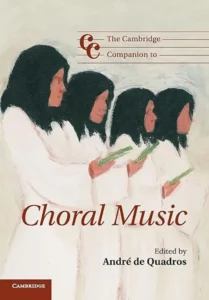 Book Chapter: The Cambridge Companion to Choral Music (André de Quadros, Editor)
Book Chapter: The Cambridge Companion to Choral Music (André de Quadros, Editor)
“. . . Two chapters follow in which Chester Alwes and Nick Strimple brief us on the developments of the nineteenth, twentieth and early twenty-first centuries. . . Strimple chooses the explosion of stylistic options in the early twentieth century as his point of departure. He wisely clusters interesting figures around the principal innovators associated with styles such as polytonality, Impressionism and dodecophony. Due attention is paid to luminaries such as Ives, Debussy, and Stravinsky, but worthy commentary concerning lesser-known music related to the World Wars and the Holocaust is a shining addition to the chapter.” – James Niblock, American Choral Review, Volume 56 Number 1 Winter/Spring 2014.
“Invaluable to both undergraduate and postgraduate music students. It would be a useful addition to a specialist music library or a university library both in this country and abroad.” – Lucy Seale, Reference Reviews.
Live Performance: Los Angeles Zimriyah Chorale and guest organist Iain Farrington
“A special event at Sinai Temple found conductor Nick Strimple presiding astutely over a combined choir and assorted other musicians in a sterling program of two honored composers, fugitives from Nazi Germany, who graced this city with their presence: Arnold Schoenberg and Eric Zeisl.
The excerpts from Schoenberg’s ‘Moses und Aron’ were deeply moving in their multi-branched soundings and Zeisl’s Requiem Ebraico soared with passionate lyricism. Here was a find — rarely heard music of great import.” – Donna Perlmutter, LA Observed, September 11, 2013.
Live Performance: “Shared Music – Shared Message: An Ecumenical Gala Concert of the Cantors Assembly” at the Berliner Dom
“Although there was no request for an autograph, two cantors in particular received a special handshake from Federal President Joachim Gauck: Nick Strimple and Tobias Brommann, who under the motto ‘Shared Music – Shared Message: An Ecumenical Gala Concert of the Cantors Assembly,’ the world’s largest organization of Jewish Cantors, organized the event in the Berlin Cathedral. Together with his life partner Daniela Schadt, Gauck listened to the beautiful Hebrew songs of the Middle Ages and the impressive works of Louis Lewandowski. Such concerts should take place much more frequently – at least according to Rolf Schieder, Professor of Practical Theology at the University of Humboldt. ‘Through memory of those who have died we are good,’ said Schieder in his opening remarks. Indeed, Christians and Jews are in need of such opportunities that allow for a shared faith.” – Benjamin Lassiwe, Berlin Daily Mirror (Der Tagesspiegel), July 2, 2012.
“This concert marks the first German tour for these seventy Jewish cantors from the USA, Canada, Europe and Israel. Together with twenty professional singers from Berlin, the program was presented under the direction of cathedral cantor Tobias Brommann and cantor Nick Strimple. Entitled “Shared Music – Shared Message,” this unique concert was the first such event in Germany’s history.” Read the entire article. – Berliner Morgenpost “When Jews and Christians join together in concert” July 2, 2012.
Music Publication: Valley of Bones
“A new year looms, and with it, I hope, the prospect of some fresh new literature to intrigue, delight, and move… I’ll begin with ‘intrigue.’ The distinguished Los Angeles-based conductor, scholar, and composer Nick Strimple has created a piece fusing the narrative of the Valley of Dry Bones with a hymn of his own composition. The story, related by a reader with organ-clusters underpinning it, and dramatic choral sound effects for the rattling bones and the rush of breath, can be performed alone (perhaps in place of the reading of the story at the Great Vigil). Or the four-stanza hymn to which this leads can stand alone; its theme is resurrection, replete with hallelujahs, and it has a nice descant on the final stanza. Or the whole might be presented together, lasting just short of six minutes. (A congregational part for the hymn is included for free duplication.)” – Alan Lewis, Ph.D., The Journal of the Association of Anglican Musicians, December 2009.
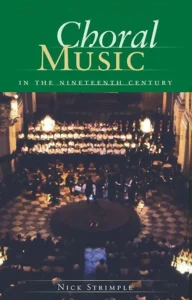 Book: Choral Music in the Nineteenth Century
Book: Choral Music in the Nineteenth Century
“If you are not acquainted with Christian Barnekow, Teodulo Mabellini, or Hans Balatka, you will be by the time you finish Nick Strimple’s exemplary survey of nineteenth century music involving choral forces. Serving as a companion volume to his earlier Choral music in the twentieth century (Amadeus, 2002), the new title explores a range of composers in both Europe and the Americas who either wrote specifically for chorus or where chorus is involved to some extent in their pieces (e.g., operas featuring major choral episodes). Strimple, a professor at the Thornton School of Music, University of Southern California, brings meticulous scholarship and a devotion to his subject to this valuable addition to the choral literature bookshelf. . . Another winner for Strimple and Amadeus!” – Barry Zaslow, Fontes artis musicae (Journal of the International Music Library Association), Fall 2010 (v.57, no.2.).
“Choral Music in the Nineteenth Century by Nick Strimple, which follows the author’s earlier volume on the twentieth century, meets the need — surprisingly unmet before — for a comprehensive single volume devoted to this field. It will spare the lover and animateur of choral music a great deal of dipping into the New Grove — particularly anyone who wishes for horizons broader than Western Europe with its ‘dead white males’. There is, in fact, scant evidence of this wish in plenty of large choirs’ concert programmes, in part no doubt because of linguistic obstacles. Strimple, however, is a director of several ensembles, and ‘minister of music’ at Beverly Hills Presbyterian Church, as well as a member of the faculty at Thornton School of Music in the University of Southern California. He is, therefore, well placed to guide those whose main interest is practical music-making.
It is this — as well as the decline of the generalist — that gives his book its old-fashioned feel. He is not afraid to quote Donald Tovey or J.A. Fuller-Maitland; and it is a patriotic pleasure to find him praising the ‘astute observations’ of Stanford and Forsyth’s A History of Music (1925), and quoting its relative estimations of Stanford’s works and their long-term prospects. The author adds some homely touches of his own: ‘Frankly, Missa solemnis and the Ninth Symphony would be much bigger surprises had Beethoven been some kind of saint; a monk or priest unblemished by any scandal, for instance, or a happily married gentleman with perfect kids and country cottage resembling something from a hideous Thomas Kinkade painting’.
There are other statements that sound odd to anyone schooled in the restrained, if not positivist, ethos of English musicology in the 1980’s: ‘This antiquated technique [the telescoping of text in Haydn’s Missa in tempore belli] at the beginning of the Credo vividly portrays a sense of doubt and confusion that all must have felt at this critical time in the Napoleonic Wars, when French troops were already camped on Austrian soil’. But all this helps to enliven a survey that must inevitably make much use of secondary sources — some comments on minor figures and their works are little more than an exercise in name-dropping — as well as include the author’s own reflections on works of which he presumably has performance experience. His enthusiasm for Central European repertoire comes over, and, as expected, he has an insider’s feel for the United States. The works lists at the back of the book are a helpful feature, and there are a few black-and-white photographs.” – Glyn Paflin, The London Times Literary Supplement (TLS), January 15, 2010.
“There is no shortage of analyses of the Requiems of Verdi and Brahms, or Haydn’s Creation. Strimple offers interesting perspectives on masterworks such as these, but also introduces us to the important works of Cherubini, Bruch, Gounod, Herzogenberg, and the dozens of other influential composers of the next tier who ranked highly with audiences and critics in their day. His special expertise in the areas of Czech and Jewish music results in excellent coverage of these areas as well. . . Strimple’s writing is clear, lively and often opinionated. This book presents a remarkable amount of information that is not easily available elsewhere, so will be an important addition to both personal and research libraries. . . it provides a unique and comprehensive look at the nineteenth-century choral landscape that should further much future research.” – William Weinert, American Choral Review, Spring 2009.
“One can thoroughly recommend this volume to anyone who is interested in the choral music of this era. The casual listener will find a wealth of ‘new’ material to explore, conductors will find new repertoire choices and choral-lovers will enjoy a thorough overview.” – Iwan Edwards, La Scena Musicale, December 18, 2008.
“Nick Strimple’s Choral Music in the Nineteenth Century will be a most welcome addition to the library of all choral artists who desire a well-researched and highly readable overview of this crucial era in music. Following his seminal survey of Twentieth Century choral music, Dr. Stimple now examines the works of earlier European and American choral composers, offering insights into each composers’ contributions to the repertoire as well as their historical contexts. . . For choral conductors, singers and program annotators, Choral Music of the Nineteenth Century will be an oft-referenced and treasured companion.” – Morten Lauridsen. Distinguished Professor of Composition, USC Thornton School of Music. Recipient, 2007 National Medal of Arts.
“Through a scholarly yet accessible writing style, Nick Strimple has illuminated 19th century choral repertoire for all levels of choral musicians. An outstanding guide with a vast knowledge of choral works and composers, Nick leads us effortlessly through the terrain of the richest and most gratifying choral music of the Romantic era. It’s a must have for anyone in choral music.” – Paul Salamunovich. Music Director Emeritus, Los Angeles Master Chorale.
“A comprehensive, current study of nineteenth-century choral music has long been needed. Nick Strimple’s expertise is ideally suited to this endeavor, for his understanding of the material as choral conductor, composer, and teacher offers the reader an overview of this literature that is informed by experience and insight…. Essential for choristers and conductors alike!” – Robert Blocker. The Henry and Lucy Moses Dean of Music, Yale University.
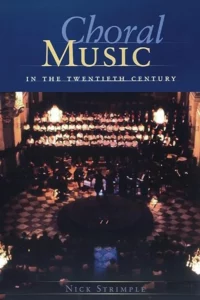 Book: Choral Music in the Twentieth Century
Book: Choral Music in the Twentieth Century
“An initial and only superficial assessment may, as it did for me, result in some scepticism regarding the value of a world survey of 20th-century choral music in about 300 pages, albeit quite closely printed. But Strimple not only has a wealth of familiarity with this repertoire and has quite obviously undertaken adventurous discovery, he is also able to express himself on the page both succinctly and engagingly. As one is drawn more deeply into the text, it becomes apparent that there is some worthy authority behind his writing.
Texas-born Strimple will this year celebrate his 60th birthday. He is the director of the Southern California Choral Society and the Los Angeles Zimriyah Chorale, lectures at University of Southern California and is active as a lively choral composer and arranger. His views are not always favourable, but he is quick to appreciate the imaginative power of scores that may be beyond the average choir as he is to take on board popular pieces that serve to entertain the vital audiences most choirs enjoy. But the greater part of this survey is about the repertoire itself and how it has developed through a turbulent century of conflict and change that has inevitably influenced the approach of composers to the coral medium.
The book begins and ends with highly perceptive essays. The first sets the world choral stage in nationalist costumes with folk, jazz and neoclassical nutrients, torn asunder by war which brought about introversion, a turning away from singing, music for children and the church, and thrown into a post-modern final phase of apparently infinite variety. The closing essay dwells on the exciting resurrection of choral challenges, from the works of the Mongolian composer Se Enkhbayar (b. 1956) to those whom Helmut Rilling commissioned to provide new Passions for the 250th anniversary of Bach’s death.
Between these are the world surveys, beginning with Austria and Germany and closing with three chapters that make up an understandably substantial portion of the book covering the USA, Canada and the Pacific Rim, which together occupy 80 pages. Inevitably, Strimple is taking an overview in each case, and it is not unexpected that such a process will both omit those we may feel are significant and highlight some unexpected names.
In the 22 pages devoted to the British Isles, which I inevitably turned to with special interest, Strimple follows the pattern he adopts for each geographical area. First he reviews major figures of the pre-war early years – Elgar and Vaughan Williams – at some length, and devotes a substantial space to Britten. A general review follows, mentioning composers from Parry and Stanford, Delius, Holst and Howells, Walton and Tippett, to a curious quartet over four pages of Tavener, Paul McCartney, Lloyd Webber and Rutter. The section closes with pieces on Wales, Scotland and Ireland, and a multitude of ‘one-liners’ that include Margaret Dryburgh, Lennox Berkeley, Rubbra, Finzi, Maxwell Davies, Maw, Patterson, David Matthews, Bob Chilcott and Thomas Ades.
All this if fine, but the imbalance (in my view) does lead me to wonder how well apportioned is his survey of ‘Greece and the Balkans’ (10 pages) or ‘Mexico, the Caribbean, Central and Southern America’ (12 pages). It is clear that Strimple has seen and heard a great deal of music that is unknown to most of us and, from his vivid descriptions, should be known.
The book, which is illustrated, includes a good bibliography, a useful composer index, and a helpful 50-page ‘Works list’ in which choral pieces are arranged according to the type of ensemble and accompaniment.” – Patric Standford, Choir & Organ Review.
“Everyone with a love of choral music – whether composer, conductor, singer or just fond admirer – should have this eloquent book in their library. Strimple, a gifted and articulate writer, has produced a volume that is easy, enjoyable and enlightening to read . . . Finally, the strongest endorsement I can offer is that this text is required reading for my graduate students.” – James Dearing, American Music Teacher, April/May 2006.
“Full of insight, analysis, and informed opinion . . . Strimple has done us a huge service with this consolidation of the last century’s choral literature.” – Timothy Sharpe, Choral Journal, October 2003.
“This is an excellent and valuable book” – Steve Holtje, Fanfare, July/August 2003.
“This volume is the first to focus on the century’s choral repertoire, and it sets a high standard . . . Not only is it the indispensable guide to choral music of the twentieth century, but it is among the most comprehensive and well-written guides to choral repertoire of any period.” – William Weinert, American Choral Review, Spring/Summer 2003.
“As an overview of what happened where, and when, this book is indeed encyclopedic. As a descriptive catalogue of all this music, this is the first book to consult.” – Peter Dale, Choir & Organ, May/June 2003.
“An essential source book for the genre.” – William McVicker, Classical Music, February 2003.
“This is a valuable and rewarding book.” – Pasatiempo, Jan. 31-Feb. 6, 2003.
“Nick Strimple offers us here a very thorough, yet concise global overview of serious choral music from the century just ended . . . Strimple writes in a straightforward, lively style, reflecting his rare understanding and deep affection for choral music . . .This significant and user friendly volume belongs in every music library as well as on the bookshelf of any choral director, scholar, singer, or serious choral aficionado.” – Lindsey Koob, American Record Guide, January/February 2003.
“[A] masterful discussion . . . Any choral director or lover of choral music would prize the Works List at the end of this volume, along with an extensive Bibliography and Index, and, of course, the book itself. It’s a gem.” – Phyllis Villec, The California Music Teacher, Fall 2002.
“This is a great book and will be helpful for professionals and music lovers . . . Nick Strimple has done an excellent and absolutely thorough job.” – Maestro Helmut Rilling.
“Nick Strimple’s volume is an essential reading for choral musicians. The global overview provides the most current information available on world choral musics. In a marketplace of mundane historical surveys, Dr. Strimple succinctly presents fact carefully balanced with scholarly comment.” – Robert Blocker, Dean, Yale University School of Music.
“Nick Strimple’s scholarly examination . . . has provided an invaluable resource for all conductors of serious choral music . . . The book promises to be a necessary addition to every conductors library. – Maestro Paul Salamunovich.
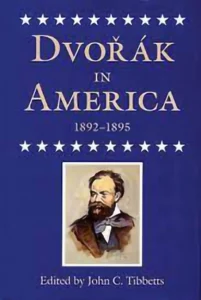 Book Chapter: Dvořák in America 1892 – 1895 (John C. Tibbetts, Editor)
Book Chapter: Dvořák in America 1892 – 1895 (John C. Tibbetts, Editor)
“What a wonderful manuscript! The most impressive aspect is the artful way the volume flows effortlessly from one chapter – and one section – to the next. Of all the books on American music at the turn of the century, none brings together so many interesting and richly interrelated dimensions as Dvorak in America. Congratulations!” – Dr. Robert Winter, Chair, Department of Music, UCLA.
From Library Journal: “Dvorak’s stay in America lasted only four years (1892-95), but he made a profound impression, especially in his position as director of the National Conservatory in New York. This is a set of 26 independent essays by scholars on topics such as his influence on American music and musicians, studies of his compositions, and his American legacy. Generally well written in a scholarly but not intimidating style, these essays give an excellent and many-faceted picture of Dvorak and of the tremendous influence his short stay had on American music. For academic music collections.” – Timothy J. McGee, University of Toronto ©1993 Reed Business Information, Inc.
Live and Recorded Performances
“This recording features particularly forceful contributions from the Choral Society of Southern California, the Los Angeles Zimriyah Chorale and narrator Theodore Bikel . . . The result is one of the best releases in the Milken Archive series to date.” – The Jewish Journal of Greater Los Angeles, April 7-13, 2006 [review of Naxos 8.559440] Reprinted in The Jewish Week, July 20, 2006.
“ . . . Special commendation to the Choral Society of Southern California, which is beautifully balanced and blended in [Judith Zaimont’s] Meditations.” – Fanfare, May/June 2006 [review of Naxos 8.559444].
“Nick Strimple’s Choral Society of Southern California gives a tremendous choral performance. With crisp diction, the sense that they know what they’re singing about, and an heroic job of maintaining pitch.” – Classical Archives, January 2006 (#94) [review of Naxos 8.559444].
“Assembling a project of this magnitude is no easy task, and all involved can be congratulated for the smooth efficiency with which the program was delivered. The sound was . . . accurate and well balanced, and the integration of the varying elements – choir, orchestra, and soloists – beautifully illuminated the driving spirit at the heart of the music. The Choral Society rendered [the music] with style and infectious enthusiasm.” – Los Angeles Times, June 12, 2001 [review of Sacred Concert by Duke Ellington].
“Nick Strimple is not only an acknowledged expert on music of the Holocaust period (Shoah) and on Jewish music in general, especially American, but he is also well-versed in Czech composers. The programme of the Prague vocal concert (20th of November) combined all his interests. . . [and was] performed with great authenticity.” – Czech Music, January/February 2001.
“In Bernstein’s Kaddish, project music director Nick Strimple has a powerful but hardly unproblematic vehicle for reconciliation. The multifarious performance challenges were generally well met here. Strimple guided the dramatic performance with care and conviction.” – Los Angeles Times, November 15, 2000.
“Formed in 1982, the Choral Society of Southern California [under the direction of Nick Strimple] is obviously a very fine choir, with a good and just balance between male and female voices. They have a bright, silvery, and distinctly American sound, placing them some distance from the less sharply etched and mellow quality of their European counterparts. Their dynamic range is large, with the most transparent quality in quiet passages, and they have an admirable sense of pitch and intonation.” – Fanfare, September/October 2000.
“The program’s midsection offered a male vocal octet, under the scrupulous direction of Nick Strimple, in a selection of Bartók arrangements of Slovak folk songs and, even more engrossingly, the quirky modalities and offbeat rhythms of the Opus 50 set of Old Hungarian Folk Songs. [Strimple’s] singers presented this rarely encountered (anywhere, we’d wager) material with a thrilling blend of concert-hall polish and folksy vigor.” – Los Angeles Times, 29 August 1994 [review of Getty Museum concert].
“Nick Strimple is one of those ardent workers in the local musical underbrush whose praise is too seldom sung. Choirmaster at Beverly Hills Presbyterian Church and founder of the Los Angeles Vocal & Instrumental Ensemble (which goes under its acronym, LA VIE), Strimple has produced important premieres in Southern California, including large-scale works by Dvorák and several new compositions. Last Saturday night at the latest of the Getty Museum’s splendid summer concerts, Strimple and LA VIE put together a program enterprising and rewarding, nicely planned and beautifully performed.” – LA Weekly, August 5, 1993.
“The performance, clearly a labor of love for all concerned, enlisted the services of . . . Nick Strimple’s Southern California Choral Society, singing with both touching sweetness and climactic heft.” – Los Angeles Times, May 30, 1992 [review of Schoenberg’s Kol Nidre].
Music & Arts CD 4921
“Our choral readers might also want to check out these anthems by Nick Strimple. [They are] interesting and expressive.” – American Record Guide, March/April 2000.
Psalm 133
“Beautiful polyphony without great difficulty.” – Caecilia (France), August 1999.
Cuchulain’s Fight with the Sea
“Its evocative orchestration (including handbells and harp), imaginative tone painting and easy flow between solo and choir, action and commentary, served well in bringing the Celtic events to life.” – Timothy Mangan, Los Angeles Times, March 16, 1994.
“Strimple’s own mettlesome setting of William Butler Yeats’ retelling of Celtic legends . . . reached an overpowering climax, with percussion and bells marvelously used.”– Alan Rich, LA Weekly, August 5, 1993.
Nativities
“[‘Nativities’ is] a well-crafted, appropriate and sometimes powerful telling of the Christmas story. In fact, with so few recent Christmas cantatas of quality accessible to both performer and listener, Nativities would be a welcome addition to the church music repertory. Strimple shifts easily from chant to angular vocal lines (in the Gesualdo tradition), from complex chord clusters to single sustained notes. And his use of thirds, unisons and imitation strengthens the drama whether shouting for joy or uttering a quiet meditation. His music, though strongly edged in Vaughan Williams-like colors and textures, is nevertheless individual and convincing.” – Kenneth Sanson, Los Angeles Times, December 20, 1983.
